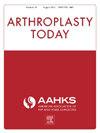Efficacy of Repeated High-Dose Versus Intermediate-Dose Intravenous Dexamethasone in Reducing Pain After Bilateral Total Knee Arthroplasty: A Randomized Clinical Trial
IF 2.1
Q3 ORTHOPEDICS
引用次数: 0
Abstract
Background
The optimal dose of intravenous (IV) dexamethasone for bilateral one-stage total knee arthroplasty (BTKA) remains controversial. Therefore, this study aimed to evaluate the efficacy of administering repeated high-dose IV dexamethasone compared to repeated intermediate-dose dexamethasone for BTKA.
Methods
In this randomized, triple-blinded, clinical trial of 46 patients who underwent BTKA were randomly divided into 2 groups. The high-dose group received 16 mg of IV dexamethasone before surgical incision and a repeated dose at 24 hours postoperatively. The intermediate-dose group received 8 mg of dexamethasone at the same time points. The outcomes measured included visual analog scale (VAS) for pain intensity during motion and at rest, morphine consumption (MC), knee flexion angle, knee strength, knee circumference, timed up and go, frequency of postoperative nausea and vomiting, high-sensitivity C-reactive protein, blood glucose levels, and complications.
Results
No significant differences were found between groups regarding VAS, except the high-dose group reporting lower VAS during motion only at 24 hours postoperatively (mean difference: −0.9, P < .001). The high-dose group had lower overall MC during the hospital stay (mean difference: −2.22 mg, P = .030) and smaller knee circumference at 24 and 72 hours (P < .05). However, the difference in VAS and MC did not reach the minimal clinically important difference (1.8 points and 10 mg, respectively). No significant differences were found between groups regarding functional recovery outcomes and biomarkers.
Conclusions
Repeated high-dose IV dexamethasone provides comparable clinical outcomes to the intermediate-dose IV dexamethasone. Therefore, intermediate-dose IV dexamethasone may be sufficient for controlling pain and inflammatory response in BTKA setting.
重复高剂量与中剂量静脉注射地塞米松减轻双侧全膝关节置换术后疼痛的疗效:一项随机临床试验
背景:双侧一期全膝关节置换术(BTKA)的最佳静脉(IV)地塞米松剂量仍然存在争议。因此,本研究旨在评价反复给予高剂量静脉注射地塞米松与反复给予中剂量地塞米松治疗BTKA的疗效。方法将46例行BTKA的患者随机分为两组。高剂量组术前静脉滴注地塞米松16 mg,术后24小时重复给药。中剂量组在同一时间点给予地塞米松8 mg。测量的结果包括运动和休息时疼痛强度的视觉模拟量表(VAS)、吗啡消耗(MC)、膝关节屈曲角度、膝关节力量、膝关节围度、起走时间、术后恶心和呕吐频率、高敏c反应蛋白、血糖水平和并发症。结果各组间VAS无显著差异,高剂量组仅在术后24小时运动时VAS较低(平均差异:−0.9,P < 0.001)。高剂量组在住院期间总体MC较低(平均差异:- 2.22 mg, P = 0.030), 24和72小时的膝围较小(P < 0.05)。然而,VAS和MC的差异没有达到最小的临床重要差异(分别为1.8分和10毫克)。两组之间在功能恢复结果和生物标志物方面没有发现显著差异。结论重复大剂量静脉注射地塞米松与中剂量静脉注射地塞米松的临床效果相当。因此,中剂量静脉注射地塞米松可能足以控制BTKA患者的疼痛和炎症反应。
本文章由计算机程序翻译,如有差异,请以英文原文为准。
求助全文
约1分钟内获得全文
求助全文
来源期刊

Arthroplasty Today
Medicine-Surgery
CiteScore
2.90
自引率
0.00%
发文量
258
审稿时长
40 weeks
期刊介绍:
Arthroplasty Today is a companion journal to the Journal of Arthroplasty. The journal Arthroplasty Today brings together the clinical and scientific foundations for joint replacement of the hip and knee in an open-access, online format. Arthroplasty Today solicits manuscripts of the highest quality from all areas of scientific endeavor that relate to joint replacement or the treatment of its complications, including those dealing with patient outcomes, economic and policy issues, prosthetic design, biomechanics, biomaterials, and biologic response to arthroplasty. The journal focuses on case reports. It is the purpose of Arthroplasty Today to present material to practicing orthopaedic surgeons that will keep them abreast of developments in the field, prove useful in the care of patients, and aid in understanding the scientific foundation of this subspecialty area of joint replacement. The international members of the Editorial Board provide a worldwide perspective for the journal''s area of interest. Their participation ensures that each issue of Arthroplasty Today provides the reader with timely, peer-reviewed articles of the highest quality.
 求助内容:
求助内容: 应助结果提醒方式:
应助结果提醒方式:


